Best Fertilizer for Lilacs | Plant Food for More Blooms
Lilacs prefer a balanced fertilizer with some micronutrients to bloom colorful flowers. Check out our recommendations below!
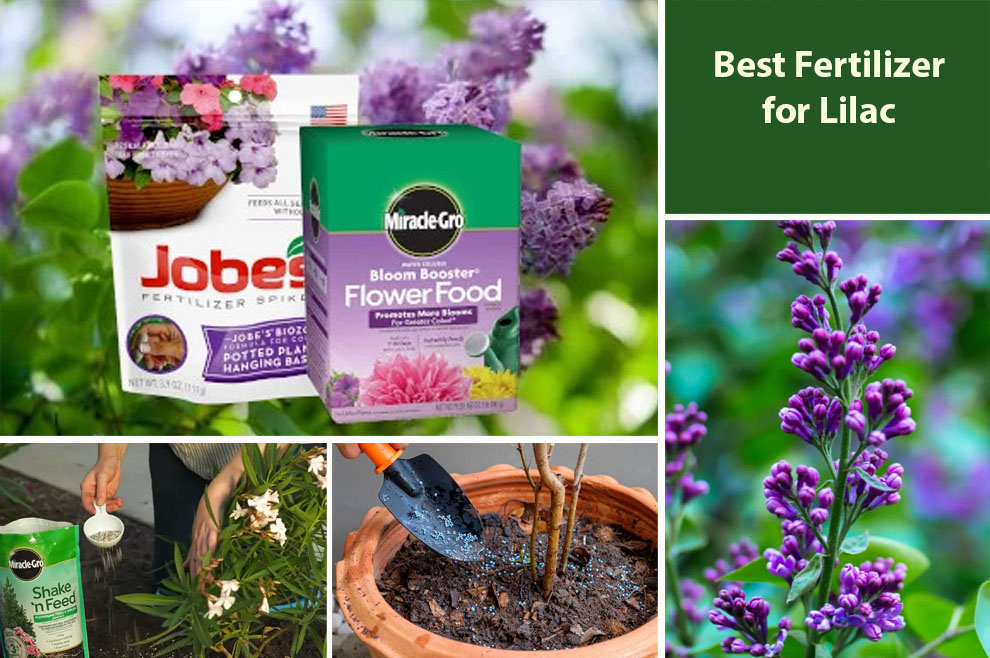
Lilacs are pretty flowers, there is no doubt about that. You must provide them with the right fertilizer for these delightful shrubs to thrive and yield abundant flowers. The best fertilizer for lilacs will be a balanced plant food with a mix of all the vital nutrients.
When picking a lilac fertilizer, we recommend a balanced nutrient ratio, such as a 14-14-14 or 10-10-10 formulation. These numbers depict the proportion of nitrogen, Phosphorous, and Potassium (NPK) in the fertilizer.
Nitrogen helps in healthy stem and leaf growth, phosphorous aids in flower production and root development, and potassium caters to the plant’s overall vigor and helps with disease resistance.
- Best Water Soluble – Jacks Classic No. 4 JR Peters Fertilizer
- Ideal for Balanced Nutrition – Miracle-Gro Bloom Booster Fertilizer
- Natural Pick for More Blooms – Espoma Organic Bone Meal Fertilizer
Though the best plant food for lilacs is a balanced fertilizer, you must also ensure the soil is rich in organic matter. Adding well-rotted manure or compost helps improve soil fertility and offers additional nutrients for the lilacs.
Regularly mulching around the plant’s base helps retain moisture and maintains soil temperature, further amplifying lilacs’ growth rate.
Hence, by offering the lilacs a balanced plant food and enriching the soil with organic matter, you encourage healthy growth, thriving lilac display, and abundant blooms that add to your yard’s beauty season after season.
Essential Nutrients for Lilacs and Their Functions
Lilacs demand specific nutrients for their optimal development and growth. Knowing the functions of each of these nutrients can help gardeners understand if and when plant health suffers due to the deficiency of these.
Here are the vital nutrients that lilac varieties need:
1. Nitrogen is necessary to promote lush foliage and vigorous growth in lilacs. It helps with chlorophyll production, an ingredient for leaves to maintain their green color.
Further, ample nitrogen also helps encourage robust stems and boost plant structure.
2. Phosphorous is vital for root development, fruit production, and flowering. It helps with energy transfer and promotes abundant and vibrant blooms.
Ample phosphorous levels accentuate the plant’s ability to endure environmental stress.
3. Potassium contributes to the different physiological processes in lilac bushes. It improves disease resistance, regulates water uptake and retention, and maintains the plant’s vigor.
Lilacs need optimum potassium levels during the flowering stage to promote healthier and larger blossoms.
4. Secondary nutrients, such as sulfur, magnesium, and calcium, are also needed by lilacs. Calcium helps with cell structure and maintaining plant integrity.
Magnesium, a chlorophyll component, helps with photosynthesis, and sulfur is crucial for protein and amino acid production.
5. Micronutrients: Lilacs need micronutrients in minute quantities, but they are equally crucial. These include boron, copper, zinc, iron, manganese, and others that help in different enzymatic processes, which stimulate metabolism, growth, and plant health.
What Should Be The Lilac Fertilizer NPK (Ideally)?
The ideal NPK ratio for lilac fertilizers is balanced, such as 14-14-14 or 10-10-10. These ratios signify a plant food with a good and even nitrogen supply for foliage growth, phosphorous for flower production, and potassium for overall health and vigor.
Best Plant Food For Lilacs
Now we will take you through some of the best fertilizers for feeding lilac plants to ensure abundant blooms and stunning growth.
1. Jacks Classic No. 4 JR Peters Fertilizer
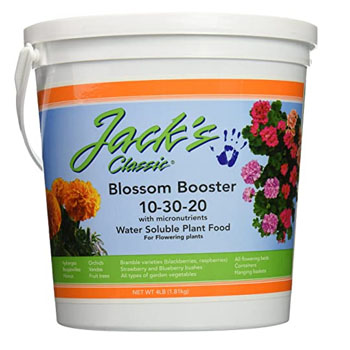 |
Check price on Amazon |
Type: Water Soluble
NPK: 10-30-20
It is an excellent lilac fertilizer and provides plants with vital nutrients to support vibrant foliage and healthy root development.
Jacks Classic ensures lush green leaves, promotes robust roots, and ensures optimal nutrition with its micronutrient composition.
It comes with a measuring spoon, making the application precise and easy. When used as directed, its safety factor prevents burning, giving you peace of mind during feeding.
You can use it on roots and leaves for efficient nutrient absorption. It gradually releases the nutrients to keep the plant fed for four months and promote vigorous growth.
2. Miracle-Gro Bloom Booster Fertilizer
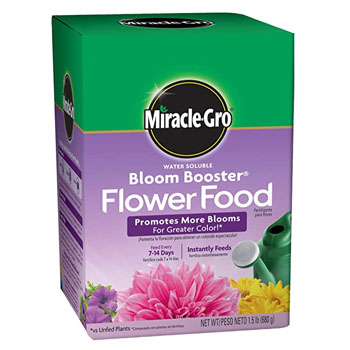 |
Check price on Amazon |
Fertilizer Type: Water soluble
NPK: 18-18-21
It is a highly recommended, gardener-trusted plant food that ensures more vibrant colors and better blooms. This fertilizer works instantly for perennial and annual flowers, making it viable and convenient.
You can apply it safely every week sans inflicting any harm to the bushes. Moreover, it is affordable and can cover a large area of 2,200 sq. ft.
3. Burpee Granular Organic Natural Plant Food
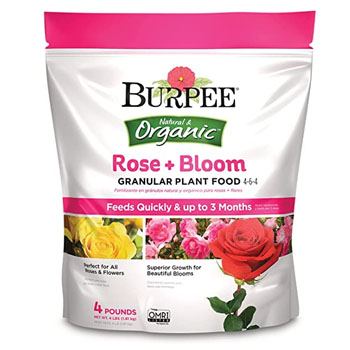 |
Check price on Amazon |
Fertilizer Type: Granular
NPK: 4-6-4
It is an OMRI-listed, natural best fertilizer for lilac bushes that delivers long-lasting and quick and long-lasting results. This plant food supplies nutrients for blossom and growth production.
It contains vital microbes that help in vibrant blooms and robust root development. It is ideal for individual bushes, established beds, and container plants, courtesy of its easy-to-spread granular consistency.
You can apply it every two months during the growing season. But please wear gloves while doing so and water thoroughly afterward.
Burpee guarantees customer satisfaction, prioritizing healthy seeds, plants, and gardening supplies for a successful gardening experience.
4. Espoma Organic Bone Meal Fertilizer
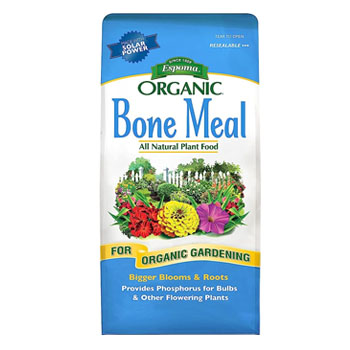 |
Check price on Amazon |
Fertilizer Type: Granular
NPK: 4-12-0
It is a slow-release, organic granular fertilizer ideal for nutrient-rich soil. You can use this for your lilacs. Given its low nitrogen ratio, it prevents fertilizer burn.
Further, this plant food has an excellent phosphorous content that produces attractive and vibrant blooms. You can use this plant food to give your plant long-lasting nitrogen, phosphorous, and calcium. It is a 100% natural and organic domestic bone meal fertilizer sans any additives or fillers.
Espoma fertilizer checks all the requirements for organic production and is organic gardening certified. It comes in an easy-to-use package for seamless application, and its slow-release formula keeps the plant well-fed for up to four months.
5. Espoma Organic Holly-Tone Fertilizer
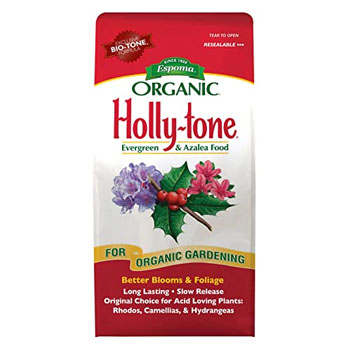 |
Check price on Amazon |
Fertilizer Type:
NPK: 4-3-4
If you find yourself thinking is holly tone good for lilacs, know that it is a trusted and original plant food that works well for acid-loving plants. Its organic and natural ingredients break down slowly, providing the lilacs with a long-lasting source of essential nutrients.
This versatile plant food is not limited to Azaleas, Rhododendrons & Hydrangeas alone and can be employed for lilacs too. Its rich blend of natural ingredients, enriched with the exquisite Bio-tone formula, ensures optimal plant growth.
Beyond its 4-3-4 NPK analysis, it has a 5 percent sulfur content. It is bereft of any toxic ingredients and sludges and is environmentally safe. This plant food is approved for organic gardening and needs no mixing.
6. TreeHelp Annual Care Kit for Lilac
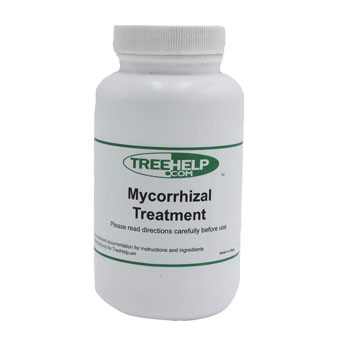 |
Check price on Amazon |
Fertilizer Type: Granular
This comprehensive care package is ideal for maintaining beautiful and healthy lilac trees. It contains effective products and helps promote long-term vitality and root development.
This fertilizer for lilac plants comprises Mycorrhizal treatment, a bag of premium fertilizer, and a bio-stimulant.
With adequate materials to treat two to three smaller/newly planted trees or one large tree, this package comes with details for easy application.
This carefully selected assortment of products ensures optimal care and nourishment vital for the growth of lilac trees.
Are Homemade Fertilizers For Lilacs Any Good?
Homemade fertilizers can be effective if properly applied and formulated. But their effectiveness varies depending on the ingredients employed and the lilac plants’ nutrient needs.
Though homemade plant foods are a cost-effective and natural alternative, you must follow proper application rates and ensure a balanced nutrient composition to avoid nutrient deficiencies and over-fertilization.
Let us look at some natural fertilizers for lilac care.
Are eggshells good for lilacs?
Eggshells can benefit lilacs when used as a soil amendment. They have calcium carbonate, which raises the pH level in acidic soil and provides a slow-release source of calcium in lilacs.
Calcium helps with root development and plant growth. Lilacs prefer acidic to neutral soil, so adding crushed eggshells can balance the pH when your soil is naturally acidic.
Is Epsom salt good for lilacs?
Epsom salt or magnesium sulfate can benefit the lilacs, provided you use it in moderation. Like several plants, lilacs also need magnesium for proper development and growth.
Thus, applying it to the soil can help supplement this nutrient. But please note that lilacs usually do not have high magnesium requirements, and prolonged or excessive use can result in magnesium build-up, causing imbalances and inflicting harm on the plants.
Hence, you must conduct a soil test before application. Also, use as directed and follow the recommended dosage to prevent damage to the bushes.
Is lime good for lilacs?
Lime can be good for lilacs in some situations. Typically, lilacs like acidic to neutral soil with a pH range between 6.0 and 7.0. If your soil is naturally acidic or the soil test indicates low pH levels, you can employ lime to increase the pH and make the soil more alkaline.
But please note not all locations or soil types need lime application. So, perform a soil test to know the pH level and nutrient composition to assess if you must add lime.
Too much lime can result in alkaline soil, which negatively affects lilac growth.
Is blood meal good for lilacs?
Blood meal can be good for lilacs, provided you use it properly. It is a natural plant food derived from dried animal blood and is a rich nitrogen source. Lilacs benefit from moderate nitrogen levels to facilitate healthy foliage growth.
However, when using blood meal on lilacs, follow the recommended application rates and avoid excess use. Too much nitrogen can result in leaf growth at the expense of flower production.
Apply it in early spring before the lilacs begin to grow actively. Further, blood meal may attract pests and animals, so take precautions to avoid unwanted visitors in your garden.
Related: How long do lilacs live?
Best Time To Fertilize Lilacs
The best time to feed your lilacs is early spring, just as new growth starts. Adding fertilizer at this time helps provide the necessary nutrients for the following growing season. Follow the instructions on the packaging label to avoid feeding during extreme heat or drought.
How To Choose The Best Fertilizer For Lilacs
Here are some factors to consider when selecting the lilac fertilizer:
1. Assess the nutrient deficiencies and soil conditions: Perform a soil test to determine the soil’s nutrient composition and pH level where your lilacs are growing. It helps you identify any specific deficiencies that you must address.
2. Slow-release vs. water-soluble and granular vs. liquid: Slow-release plant foods offer a steady nutrient supply over an extended period, whereas water-soluble ones ensure quick results.
However, the latter needs more frequent application.
3. Cost and convenience: Consider your application method preference and the cost-effectiveness, as some fertilizers come with complementary features like convenient packaging options and measuring spoons at no added costs.
4. Recommendations for specific lilac varieties or conditions: Some environments or lilac species have distinct nutrient requirements or pH preferences.
So choose a plant food recommended for your specific lilac and address the particular needs of your newly planted or established lilacs.
Knowing these factors, you can pick a fertilizer that best meets your lilacs’ needs and provides the plant with the necessary nutrients to ensure abundant blooms and healthy growth.
